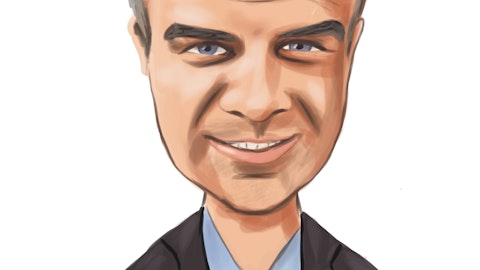And then a bolus of sites that really come on between March, April, and May, such that we’ll have most of our sites. We’ll have over 100 sites participating in this trial globally, and we’ll have most of those sites active by mid-year. And so, we can €“ we’ll report out, kind of at that point. I think that will be a more meaningful update on progress because it’s at that point where you’ve really gotten into your early enrollment curve and site activation needs to be on-track at that point in order to get to your final time line. So, I look for that next update and our midyear update as maybe more meaningful insight into that progress. But so far, early stage on track.
Naureen Quibria: Sure. Got it. And just one more. Can you just remind us maybe Josh or Allen or maybe, Mike, how soon after patients are undergoing treatment with radiation? This is for the ACTION study. Are you able to capture those with the mutations? At what point are the patients diagnosed with the mutation and then actually captured into the study?
Mike Sherman: Sure. Maybe, Allen, if you want to talk through that diagnosis and Progression II study?
Allen Melemed: I’m not sure which Allen. You’re talking to me?
Mike Sherman: Allen Melemed.
Allen Melemed: Thank you. So, the way the screening process is, we can actually screen while they’re receiving their radiation therapy. So, they initially diagnosed with surgery biopsy. We will then find out the mutational status and we can serve the screening process from them. They won’t be randomized until after they’ve received the radiation therapy, and then they can be randomized. And we have a very pretty long period of when they’ve completed radiation to when they can randomize so we can capture most of the patients. So, we’re really trying to capture them in a long period. So, we can get them early when they’re diagnosed and then follow them during the radiation they will give them some time period afterwards when they can actually get to an open site. Does that answer your question?
Naureen Quibria: Yes. Yes. Thank you. That’s all for me.
Operator: Soumit Roy with Jones Research. Your line is open.
Soumit Roy: Hi, everyone and congratulations, again, on the progress on 206. So, I’m just curious like what made you decide to expand the 206 enrollment beyond H3 K27M-mutation? And if you think even 201 could have a broader efficacy beyond just the focused population?
Mike Sherman: Yes, I’ll start that and maybe, Josh, you can add to it. I think our strategy from the beginning was to differentiate ONC206 into new populations that was supported by the preclinical data, as well as, obviously, it’s a logical from a pipeline progression standpoint. So, the ability to tap outside of H3 K27M, it essentially opens up, sort of, I think, six-fold the patient population that we get with that agent with ONC201, which in and of itself is still a very interesting and attractive market, but we’ll develop it outside of that as ONC201 would address H3 K27M. There are other potential opportunities for ONC201, smaller, I think, niche opportunities around that. So, to the extent that we see ONC206 have this broader activity, it would become the workhorse agent where we would defer to that in expanding new indications or potentially even beyond CNS tumors.
Josh, I don’t know if you want to add anything to €“ in terms of the evidence or rationale for going broader and beyond the ONC201 indication targets?
Josh Allen: Yes, I’ll expand on that. And I think the answer is, we really followed the data from the preclinical studies, right? So, the activity profile of ONC206 we found to be much, much broader than ONC201. We have preclinical data, both in vitro and in vivo in a series of indications, namely several high gliomas that don’t include the H3 K27M-mutation in-line with that response that we highlighted here today. But in addition, in other forms of neuroendocrine tumors, like cholangiocarcinoma, and then including ovarian and endometrial cancer. So, it’s really the observations in the lab suggesting that this drug could address several forms of advanced cancers outside of H3 K27M glioma that led to us making the clinical program more broad than CNS tumors for that first half.





